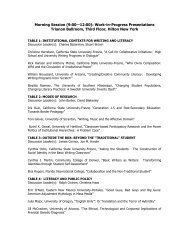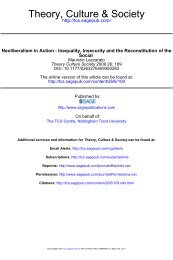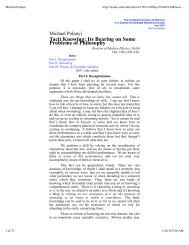PUBLIC OPINION by WALTER LIPPMANN TO FAYE LIPPMANN ...
PUBLIC OPINION by WALTER LIPPMANN TO FAYE LIPPMANN ...
PUBLIC OPINION by WALTER LIPPMANN TO FAYE LIPPMANN ...
Create successful ePaper yourself
Turn your PDF publications into a flip-book with our unique Google optimized e-Paper software.
3<br />
Circulation is, therefore, the means to an end. It becomes an asset<br />
only when it can be sold to the advertiser, who buys it with revenues<br />
secured through indirect taxation of the reader. [Footnote: "An<br />
established newspaper is entitled to fix its advertising rates so that<br />
its net receipts from circulation may be left on the credit side of<br />
the profit and loss account. To arrive at net receipts, I would deduct<br />
from the gross the cost of promotion, distribution, and other expenses<br />
incidental to circulation." From an address <strong>by</strong> Mr. Adolph S. Ochs,<br />
publisher of _the New York Times,_ at the Philadelphia Convention<br />
of the Associated Advertising Clubs of The World, June 26, 1916.<br />
Cited, Elmer Davis, _History of The New York Times,_ 1851-1921,<br />
pp. 397-398.] The kind of circulation which the advertiser will buy<br />
depends on what he has to sell. It may be "quality" or "mass." On the<br />
whole there is no sharp dividing line, for in respect to most<br />
commodities sold <strong>by</strong> advertising, the customers are neither the small<br />
class of the very rich nor the very poor. They are the people with<br />
enough surplus over bare necessities to exercise discretion in their<br />
buying. The paper, therefore, which goes into the homes of the fairly<br />
prosperous is <strong>by</strong> and large the one which offers most to the<br />
advertiser. It may also go into the homes of the poor, but except for<br />
certain lines of goods, an analytical advertising agent does not rate<br />
that circulation as a great asset, unless, as seems to be the case<br />
with certain of Mr. Hearst's properties, the circulation is enormous.<br />
A newspaper which angers those whom it pays best to reach through<br />
advertisements is a bad medium for an advertiser. And since no one<br />
ever claimed that advertising was philanthropy, advertisers buy space<br />
in those publications which are fairly certain to reach their future<br />
customers. One need not spend much time worrying about the unreported<br />
scandals of the dry-goods merchants. They represent nothing really<br />
significant, and incidents of this sort are less common than many<br />
critics of the press suppose. The real problem is that the readers of<br />
a newspaper, unaccustomed to paying the cost of newsgathering, can be<br />
capitalized only <strong>by</strong> turning them into circulation that can be sold to<br />
manufacturers and merchants. And those whom it is most important to<br />
capitalize are those who have the most money to spend. Such a press is<br />
bound to respect the point of view of the buying public. It is for<br />
this buying public that newspapers are edited and published, for<br />
without that support the newspaper cannot live. A newspaper can flout<br />
an advertiser, it can attack a powerful banking or traction interest,<br />
but if it alienates the buying public, it loses the one indispensable<br />
asset of its existence.<br />
Mr. John L. Given, [Footnote: _Making a Newspaper_, p. 13. This<br />
is the best technical book I know, and should be read <strong>by</strong> everyone who





